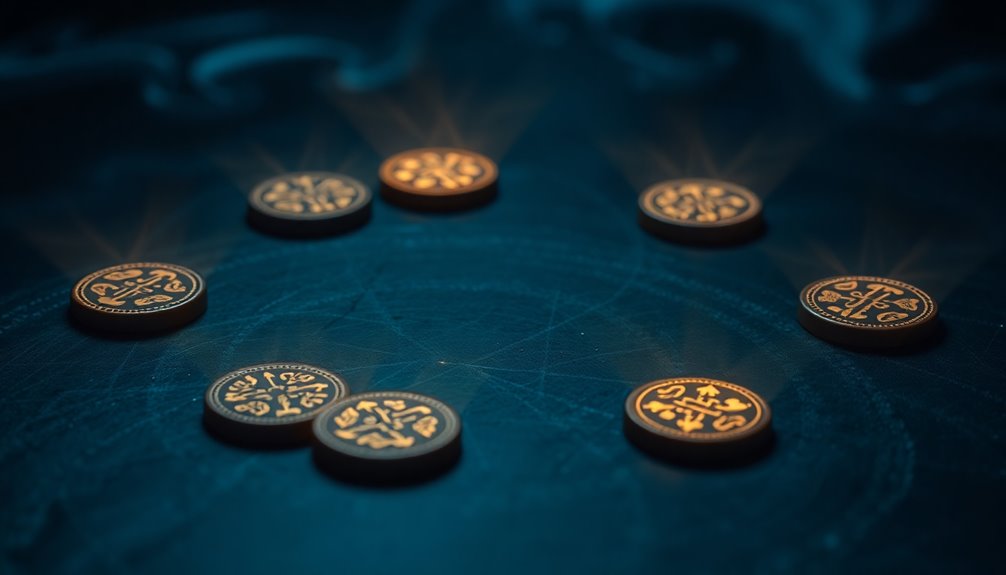The Seven Seals of Revelation are essential to understanding Christian eschatology. You'll find them in Revelation chapters 5, 6, and 8, where they unveil crucial prophetic events leading to Christ's return. Each seal, opened by Jesus, reveals significant judgments affecting human history. The first four seals introduce the Four Horsemen, symbolizing conquest, war, famine, and death. The fifth seal highlights the cries of martyred believers, while the sixth features cosmic disturbances as signs of God's wrath. Finally, the seventh seal indicates a moment of silence, emphasizing the gravity of what's to come. There's much more to explore about these profound symbols.
Key Takeaways
- The Seven Seals, found in Revelation chapters 5-8, reveal prophetic events leading to the Second Coming of Christ.
- Each of the first four seals introduces the Four Horsemen, symbolizing conquest, war, famine, and death.
- The Fifth Seal highlights the cries of martyred believers for justice, reflecting historical Christian persecution.
- The Sixth Seal describes catastrophic cosmic disturbances as signs of divine judgment and impending wrath.
- The Seventh Seal marks silence in heaven, indicating a transition to the final judgments and the seriousness of forthcoming events.
Introduction

The Seven Seals of Revelation hold immense significance in Christian eschatology, as they unveil a series of prophetic events leading to the Second Coming of Christ. Found in the Book of Revelation, particularly in chapters 5, 6, and 8, these seals represent divine judgments that unfold progressively throughout history.
When Jesus Christ, the Lamb, opens each seal, distinct events are revealed, shaping the course of human experience.
The first four seals introduce the infamous Four Horsemen, symbols of conquest, war, famine, and death. Each rider brings forth a specific judgment, signaling the chaos and turmoil that precede the end times.
As the narrative progresses, the Fifth Seal reveals the cries of martyrs, who seek justice for their suffering, highlighting the struggle of the faithful against persecution.
The Sixth Seal escalates the tension with catastrophic cosmic events that shake the very foundations of creation.
Finally, the Seventh Seal brings a profound silence in heaven, marking a pivotal transition in divine judgments and preparing the world for the final events of the apocalypse.
This silence invites reflection on the gravity of the unfolding divine plan, compelling you to consider your own role in this prophetic narrative.
Scriptural Basis for Seals
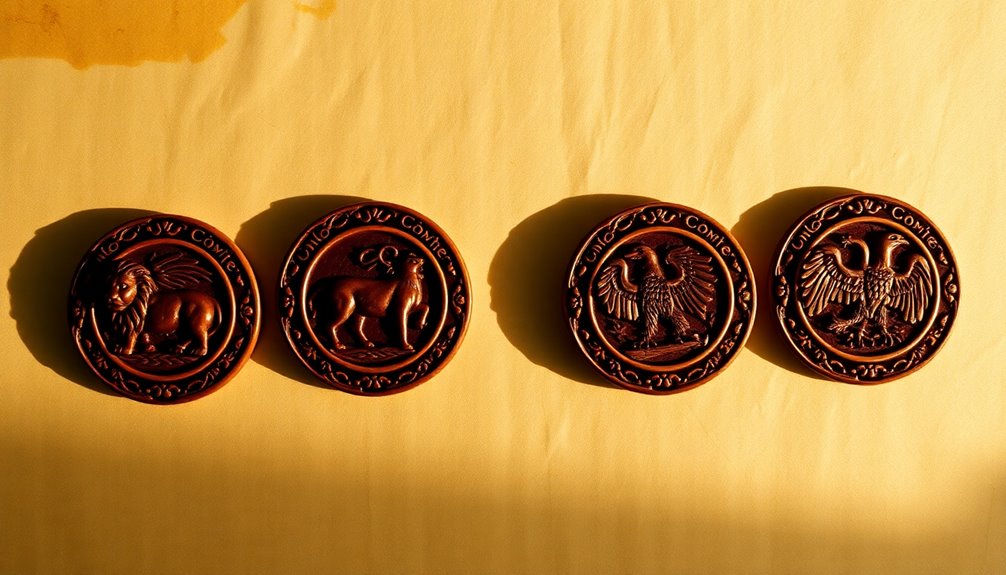
When you explore the scriptural basis for the Seven Seals, you'll find that the primary references in Revelation chapters 5, 6, and 8 lay the groundwork for understanding their significance.
Additionally, secondary references throughout the Bible provide context and deepen your insight into these apocalyptic symbols.
Let's unpack these critical texts to grasp their meaning and implications more fully.
Primary Bible References
In the Book of Revelation, you'll uncover the significance of the Seven Seals, primarily detailed in Revelation 5:1-14, 6:1-17, and 8:1-5. Each seal represents distinct apocalyptic events that unfold as they're opened.
The first four seals introduce the Four Horsemen of the Apocalypse, who symbolize conquest, war, famine, and death. These figures illustrate the chaos and suffering that humanity faces.
As you delve deeper, the Fifth Seal (Revelation 6:9-11) reveals the souls of martyrs crying out for justice, emphasizing the persecution believers have endured throughout history. This powerful imagery highlights their sacrifice and the hope for divine retribution.
Next, the Sixth Seal (Revelation 6:12-17) describes catastrophic cosmic disturbances, including a great earthquake, a darkened sun, and falling stars. These phenomena signal divine judgment and the seriousness of the unfolding events.
Finally, the Seventh Seal (Revelation 8:1) brings a profound silence in heaven, marking a significant pause before the next wave of judgments represented by the seven trumpets. This silence underscores the gravity of what's to come, urging you to reflect on these profound revelations.
Secondary Bible References
Exploring the secondary biblical references to the Seven Seals reveals a rich tapestry of prophetic connections throughout Scripture. The seven seals, primarily detailed in Revelation, encapsulate pivotal apocalyptic events that shape the narrative of the end times. For example, the First Horseman, who rides out on a white horse, symbolizes conquest and is linked to the unfolding events leading to the Second Coming of Christ.
The Fifth Seal introduces a poignant moment, as it reveals the cries of those martyred for their faith, emphasizing their longing for divine justice. This theme resonates throughout Scripture, highlighting the ultimate victory over suffering.
Similarly, the sixth seal unleashes catastrophic cosmic phenomena, such as earthquakes and celestial disturbances, which echo prophetic warnings found in the Old Testament.
Finally, the Seventh Seal brings about a moment of silence in heaven for about half an hour, signaling the solemnity before final judgments.
Roman Empire's Persecution of Christians
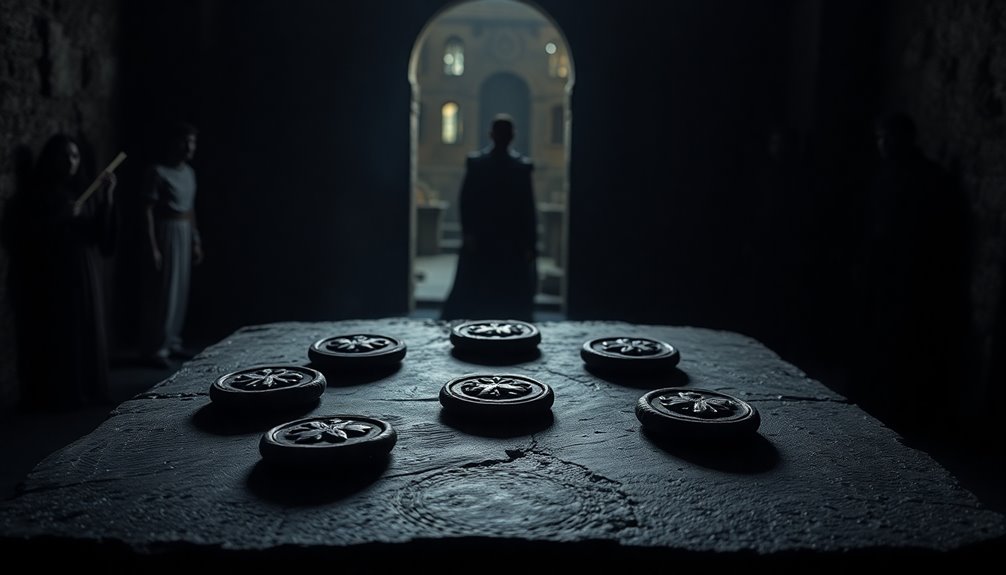
The brutal reality of the Roman Empire's persecution of Christians unfolded dramatically, particularly during the reigns of emperors like Nero and Diocletian. Under Nero, Christians faced horrifying consequences after he blamed them for the Great Fire of Rome in 64 AD. This persecution sealed their fate, leading to torture and death, as they were deemed unworthy by the Emperor.
The oppressive climate only worsened under Domitian, who demanded worship as a god, resulting in the exile of John of Patmos and the martyrdom of many steadfast Christians.
The Decian persecution in the early 3rd century mandated sacrifices to Roman gods, pushing Christians to resist, often at the cost of their lives. Then came the Great Persecution under Diocletian, which involved systematic efforts to destroy Christian scriptures and churches.
The scroll of suffering for countless believers was lengthy, as thousands faced execution simply for their faith in God.
Despite the relentless persecution, Christianity thrived, showcasing a resilience that would eventually lead to its legalization in 313 AD with the Edict of Milan. This resilience serves as a powerful testament to the faith's enduring strength amidst unimaginable trials.
Symbolism of the Seals

Throughout the Book of Revelation, the Seven Seals symbolize pivotal apocalyptic events and divine judgments that reflect humanity's ongoing spiritual and moral struggles. Each seal, when broken, reveals a significant occurrence that impacts the world profoundly.
The first seal introduces a rider on a white horse, often seen as a representation of false peace or the Antichrist, marking the onset of a deceptive tranquility before tribulation ensues.
As you progress to the second seal, you encounter a rider on a red horse, symbolizing warfare and the removal of peace from the earth, ushering in widespread conflict and bloodshed.
The third seal presents a rider on a black horse, signifying famine, where economic hardship becomes evident through soaring food prices, highlighting the dire consequences of scarcity.
Finally, the fourth seal unveils a pale horse, whose rider is named Death. This imagery signifies widespread mortality and destruction, with prophecy indicating a significant loss of life across the globe.
Together, the symbolism of the seals illustrates a chilling narrative of humanity's struggles against spiritual and moral decay, setting the stage for the unfolding apocalyptic vision.
Misunderstanding the Fifth Seal
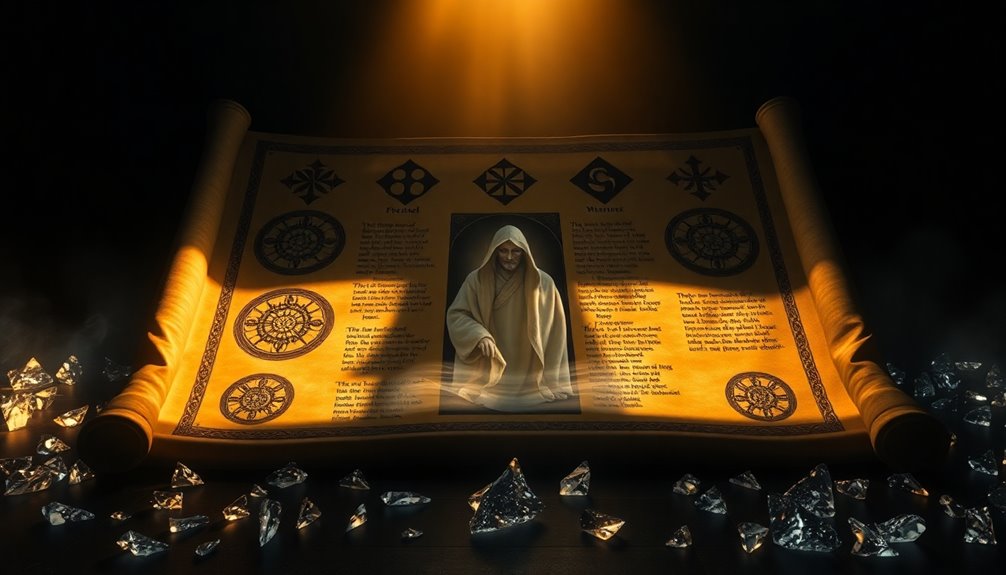
When you explore the Fifth Seal in Revelation, it's easy to misinterpret its timing and significance.
Many assume it only reflects the Great Tribulation, but it actually highlights the enduring struggle of martyrs across history.
Understanding this can deepen your appreciation for the ongoing call to patience and faithfulness among believers today.
Debunking Common Misconceptions
Misunderstanding the Fifth Seal often leads to a skewed perception of its message. Many see the souls of martyrs under the altar as merely seeking revenge, overlooking their true plea for divine justice. These martyrs, adorned in white robes, symbolize purity and victory, not despair or hopelessness.
Instead of isolating the Fifth Seal within a specific historical context, it's crucial to recognize it as a broader representation of martyrdom throughout church history.
The Fifth Seal occurs after the first four seals, emphasizing the ongoing struggle believers face during times of persecution. This reveals the tension between divine sovereignty and human suffering, reminding you that God is aware of the plight of His faithful followers. Misconceptions often limit the understanding of this seal, failing to appreciate its relevance across the ages.
Ultimately, the Fifth Seal serves as a powerful reminder of the endurance of believers against evil, encouraging you to see it as part of a larger narrative rather than a standalone event.
In doing so, you'll grasp the profound message of vindication and hope that the Fifth Seal truly embodies.
Misinterpretation of the Seals
Many readers struggle to grasp the true meaning behind the Fifth Seal in Revelation. This passage reveals the souls of martyrs under the altar, symbolizing those who faced Christian persecution, especially during the Roman Empire.
Their cries for vengeance are often misinterpreted as a desire for personal revenge, but this view misses the point. Instead of seeking retribution, these martyrs yearn for divine justice and God's ultimate judgment against their oppressors.
The imagery of white robes signifies purity and righteousness, affirming that these believers are accepted into heaven despite their earthly suffering.
It's crucial to understand that the Fifth Seal holds significant eschatological implications. It reflects ongoing spiritual struggles faced by believers throughout history, not just a singular event or time period.
Faith During Tribulation Challenges

When you face trials during tribulation, endurance becomes essential for your faith.
Leaning on your community can help you find strength and resilience in suffering, reminding you that you're not alone in this journey.
Together, you can support one another and grow stronger in your beliefs amidst the challenges.
Endurance Through Trials
Enduring trials during the tribulation can feel overwhelming, but it's crucial to hold onto your faith. The opening of the seven seals introduces the Four Horsemen, symbolizing the various trials you may face, including false peace, war, famine, and death. Each of these challenges can test your endurance and perseverance, yet they also remind you of the importance of steadfastness in your beliefs.
As you reflect on the fifth seal, consider the cries of martyred believers who endured persecution for their faith. Their examples highlight the hope for divine justice amidst suffering.
The catastrophic events associated with the sixth seal, like the great earthquake, serve as urgent reminders for you to remain faithful, even when chaos surrounds you.
In a world where many hearts may harden, your spiritual preparation is vital. The silence of the seventh seal signifies the gravity of final judgments, encouraging you to endure and keep hope alive as you await Christ's victory.
Community Resilience in Suffering
Suffering during tribulation can be isolating, but it often brings communities together in powerful ways. The seven seals of Revelation illustrate various tribulations, like war, famine, and death, which challenge your faith in Christ. During these difficult times, community resilience can shine as believers unite against adversity, drawing strength from shared beliefs.
Historically, the persecution of Christians during the Roman Empire exemplifies this unity. Faith communities found hope and solidarity, transforming suffering into a catalyst for collective action. The cries of Christian martyrs from the fifth seal remind you that their sacrifices inspire resilience and reinforce your commitment to faith amidst challenges.
The cosmic disturbances of the sixth seal emphasize the need for spiritual readiness, urging you to rely on your faith while supporting one another. In these tribulations, the anticipated return of Christ serves as a beacon of hope, encouraging you to endure and resist despair. This collective strength mirrors the power of community resilience, highlighting how shared struggles can lead to profound transformations.
Ultimately, community resilience during suffering not only fortifies individual faith but also cultivates a profound sense of purpose, reminding all believers that divine justice and restoration await on the horizon.
Seals Signify Divine Judgment
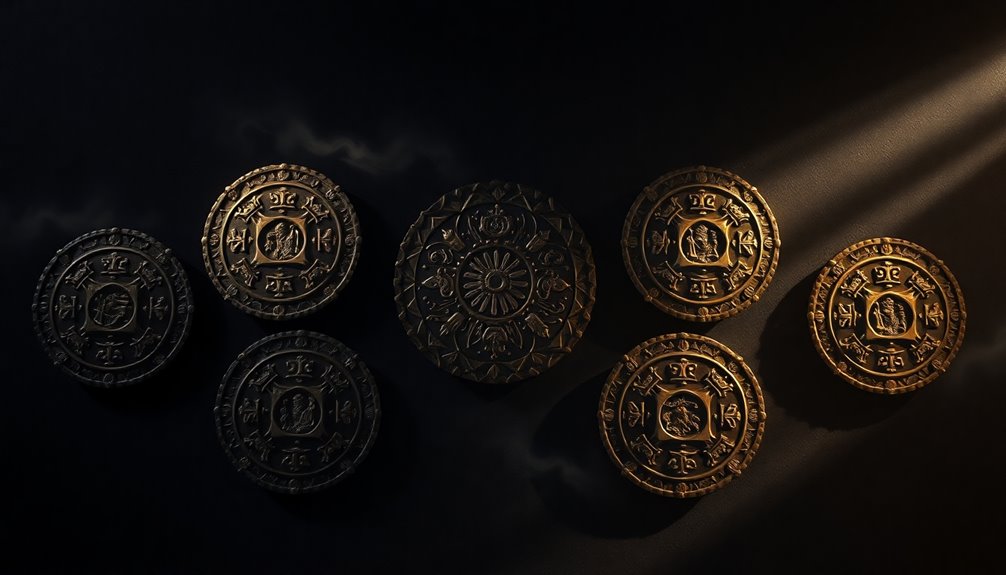
The Seven Seals in the Book of Revelation clearly signify divine judgment, each one unleashing a distinct wave of apocalyptic events that profoundly affect humanity. As you explore these seals, you'll notice how they initiate a series of divine judgments that culminate in chaos and suffering.
The emergence of the Four Horsemen—conquest, war, famine, and death—serves as a stark reminder of humanity's rejection of God.
When the fifth seal is broken, the cries of martyred believers seeking justice echo through the heavens, illustrating God's response to persecution and affirming the importance of faith amidst trials.
The sixth seal brings catastrophic events, including a great earthquake and celestial disturbances, signaling God's impending wrath on unrepentant souls.
As the seventh seal opens, a profound silence envelops heaven, underscoring the gravity of the judgments to come. This silence reflects the solemnity surrounding the final judgment and the eventual restoration of creation.
Through these seals, you witness not only the consequences of human actions but also the divine promise of ultimate justice and renewal.
Additional Resources

When exploring the Seven Seals of Revelation, you might find it helpful to delve into additional resources that provide deeper insights and interpretations. Numerous commentaries focus on Revelation chapters five through eight, explaining the significance of each seal.
For instance, the first four seals introduce the infamous Four Horsemen: the white horse representing conquest, the red horse symbolizing war, the black horse depicting famine, and the pale green horse signifying death.
To further understand the themes of suffering and justice, consider studying the Fifth Seal, where the cries of martyrs resonate deeply. This exploration can enhance your comprehension of the ongoing struggle for faith amidst persecution.
The Sixth Seal is another critical area to examine, as it triggers catastrophic cosmic phenomena, such as earthquakes and darkened skies, often perceived as harbingers of judgment.
Finally, don't overlook the Seventh Seal, which brings a profound silence in heaven, setting the stage for the final judgments through the seven trumpets. By engaging with these resources, you can gain a richer understanding of the complex symbolism and prophetic messages found within the seven seals.
Frequently Asked Questions
What Are the 7th Seals in Revelation?
The seventh seal represents a significant moment of silence in heaven, lasting about half an hour.
This silence emphasizes the gravity of the events about to unfold, creating a sense of anticipation and awe.
It's a pause before the next phase in the apocalyptic narrative begins.
You can see this as a moment of reflection and preparation for the seven trumpets that follow, signaling further divine judgments and events on earth.
What Are the 7 Signs in Revelations?
In Revelation, you'll find various signs that signal the end times.
These include the emergence of false prophets, wars, famines, and natural disasters.
You'll also notice the rise of the Antichrist, a great persecution of believers, and the spread of the Gospel to all nations.
Each sign serves as a warning, urging you to stay vigilant and prepared for the significant changes that will unfold in the world around you.
Have the 7 Seals Been Opened?
You might wonder whether the seven seals have been opened. Many interpretations suggest that significant events throughout history, like wars and natural disasters, reflect the unfolding of these seals.
Some believe the first few have already manifested, while others argue the process is ongoing. As you explore this topic, consider how different perspectives interpret these events and what they mean for the future.
The answer might depend on your beliefs and interpretations.
What Is the Meaning of the Book With Seven Seals?
The book with seven seals represents a profound mystery and divine authority. It signifies the unfolding of significant events that shape human history and destiny.
Each seal reveals a different aspect of judgment or revelation, calling attention to the struggles and triumphs you might face. As the seals are opened, they invite you to reflect on your own faith, endurance, and understanding of the ultimate purpose behind the trials and tribulations of life.

